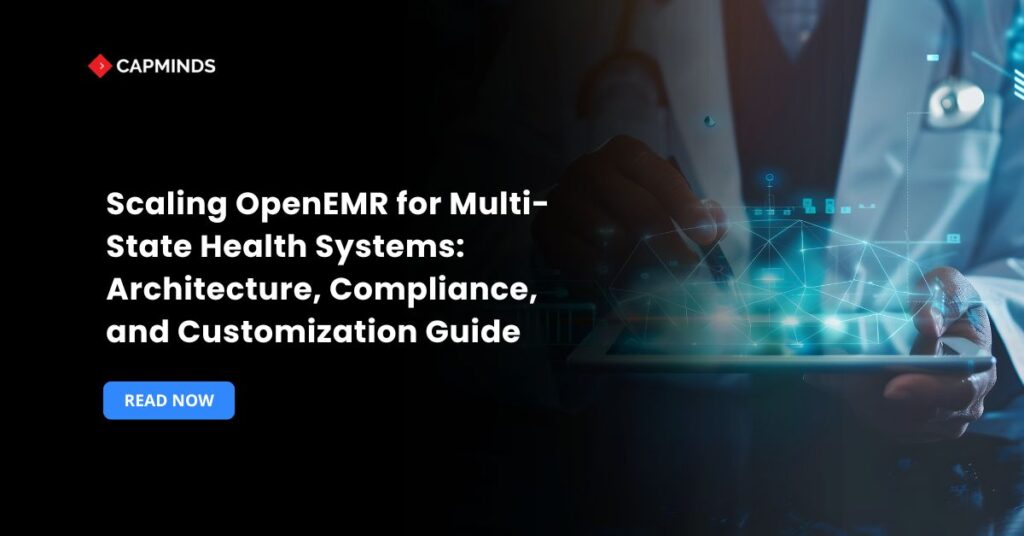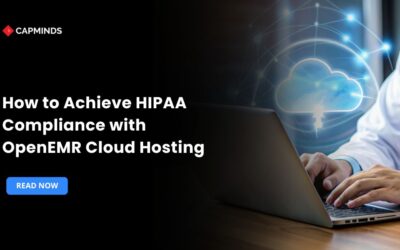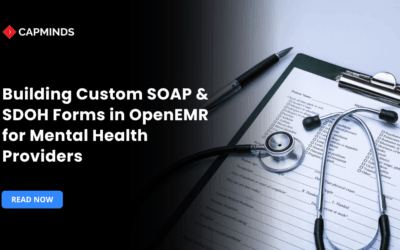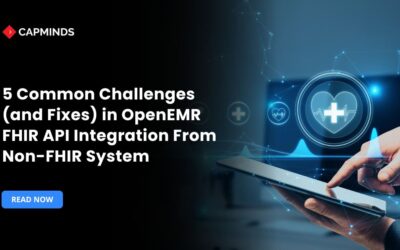Scaling OpenEMR for Multi-State Health Systems: Architecture, Compliance, and Customization Guide
As healthcare organizations expand across various locations, the need for a scalable, compliant, and highly customizable EHR system becomes critical. OpenEMR, being open-source, offers robust customization and scalability, but optimizing it for multi-state operations requires strategic planning.
In this blog, you’ll learn how to plan, configure, and maintain OpenEMR for multi-state healthcare systems, with a focus on system design, data integrity, and regulatory compliance.
1. Scalable Architecture for Multi-state Deployment
To ensure consistent performance and dependability across locations, a scalable system architecture is required.
Key Architectural Models
Centralized Architecture
- A single OpenEMR instance hosted in the cloud, such as AWS or Azure.
- A shared database with role-based access for location-specific providers. Easy to maintain and update.
- Risks include slow access to distant locations, dependence on central uptime.
Federated Architecture
- Independent OpenEMR instances per state or region.
- Centralized master data repository with synchronization protocols.
- Provides better regional autonomy and performance.
Hybrid Architecture
- Centralized core modules and Master Patient Index (MPI).
- State-specific customizations are hosted separately.
- Ideal for organizations balancing shared services with local autonomy.
Technology Stack Recommendations
- Load balancing with NGINX or HAProxy.
- High-availability MySQL clusters or Aurora DB.
- Dockerized deployment for modular scaling.
- Kubernetes for container orchestration and management.
2. Data Governance and Compliance Across States
Operating in multiple states introduces layers of regulatory complexity that must be addressed proactively.
Compliance Considerations
- HIPAA (National): This must be the baseline for all occurrences.
- State-specific laws include California’s CCPA, New York’s SHIN-NY, and the Texas Medical Privacy Act.
- Differences in consent management, data sharing, and breach notification protocols.
Best Practices
- Segment data access and storage by state or region.
- Use detailed audit trails to monitor access and modifications.
- Implement role-based access and multi-tenant management.
- Apply override rules for states with stricter privacy requirements.
Governance Tools
- OpenEMR’s native Access Control Lists (ACL).
- Syslog integration and third-party SIEM tools.
- Data Loss Prevention (DLP) plugins or external modules.
3. Customization of Regional Clinical Workflows
Different states may require different documentation standards, billing processes, and clinical workflows.
Customization Requirements
- Immunization tracking, Medicaid-specific documentation, and behavioral health reporting.
- Variability in CPT/ICD code sets across states.
- State-level clinical regulations, e.g., opioid prescription limitations.
Tools and Strategies
- Module Framework: Build and deploy custom plugins.
- Form Builder: Use layout-based tools to rapidly configure state-specific forms.
- API Integrations: Connect with state-level health information exchanges (HIEs) and registries.
- Language Packs: Enable multilingual interfaces based on local demographics.
Related: Cut EHR Licensing Costs by 60%: OpenEMR vs. Legacy Systems for Enterprise-Scale Operations
4. Centralized and Decentralized Data Strategies
A key decision for multi-state health systems is choosing between centralized and decentralized data handling.
Centralized Data Strategy
Pros: Include unified patient records, centralized analytics, and improved compliance.
Cons: More sophisticated access control and latency issues.
Decentralized Strategy
Pros: Include easier regional compliance and localized control.
Cons: Data silos unless connected using interoperability layers.
Use FHIR APIs to synchronize patient data and maintain a unified MPI. Apply ETL tools for centralized reporting and analytics across instances.
5. Interoperability Across State Systems
Multi-state operations demand real-time, seamless data exchange among facilities and third-party entities.
Key Integrations
- Integration with state-run HIEs.
- Reporting to immunization registries (via HL7 v2).
- Electronic prescribing via eRx networks like SureScripts.
- Public health surveillance for reportable conditions.
Tools and Standards
- OpenEMR FHIR API support (v1 and v2).
- SMART FHIR Apps for Third-Party Modules
- Use Mirth Connect or similar integration engines for HL7 connections.
6. Role-Based Access & Identity Management
Granular access control is essential to manage user roles across a distributed network.
- Super Admin (National-Level) Full access in all states.
- State administrators have access to and handle specialized regional data.
- Permissions for providers and clinical staff are location- and patient-specific.
Best Practices
- Define groups and permissions using OpenEMR’s ACL system.
- Integrate with LDAP or enable SSO (Single Sign-On) for secure, scalable identity management.
7. Performance Monitoring and Maintenance
With more users and locations, proactive system health monitoring is essential.
Monitoring Tools
- Prometheus & Grafana: For infrastructure and database health.
- New Relic / Datadog: For application performance.
- ELK Stack (Elasticsearch, Logstash, Kibana): For real-time log monitoring and troubleshooting.
Maintenance Practices
- Regular backups and database optimizations.
- Timely application of security patches and OpenEMR updates.
- Load testing to assess performance during peak usage.
Related: Reengineering EHR Infrastructure at Scale: The Strategic Advantage of OpenEMR
CapMinds OpenEMR Customization and Integration Service
CapMinds OpenEMR equips clinicians with the best features and ways to integrate. It makes their workflows more efficient and filtered.
The integrated features will allow them to combine the ability of patient record management with conceptual and concurrent reminders.
This enhances the process of decision-making and improves patient care and quality.
- At CapMinds, OpenEMR custom solutions are developed with much care and accuracy to match the special practice needs.
- It will be low-cost and the perfect budget solution for your practice’s long-term future.
- CapMinds OpenEMR prioritizes secure data management & ensures compliance with industry regulations, offering healthcare providers peace of mind.
Get the best technologies and HIPAA-compliant and efficient OpenEMR from CapMinds that can be tailored to fit your practice.
Our OpenEMR services facilitate a Modern User Interface (UI), customization, production support & training. It also facilitates billing, reporting, specialty enhancements, clearing house integrations, e-prescribing, cloud, and more.
“Get the most experienced, proven, and perfect professional support for your OpenEMR.”




